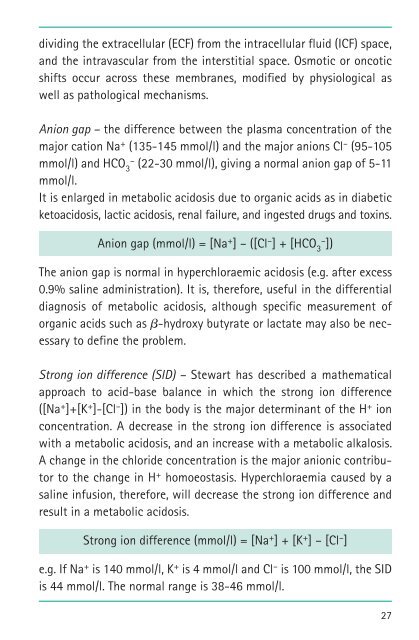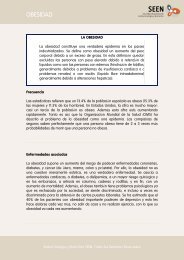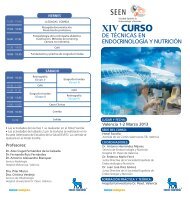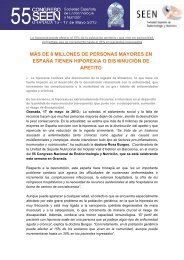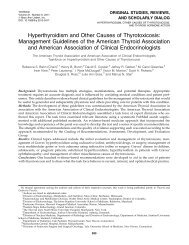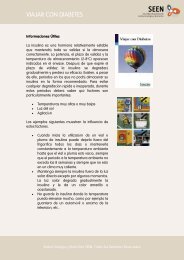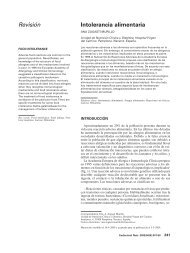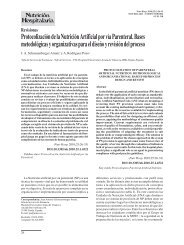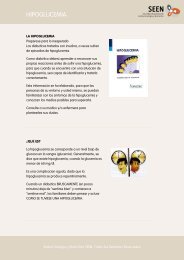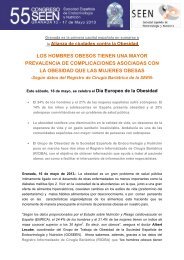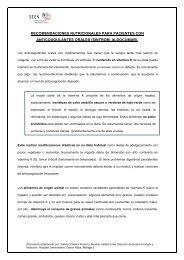Basic Concepts of Fluid and Electrolyte Therapy
Basic Concepts of Fluid and Electrolyte Therapy
Basic Concepts of Fluid and Electrolyte Therapy
You also want an ePaper? Increase the reach of your titles
YUMPU automatically turns print PDFs into web optimized ePapers that Google loves.
dividing the extracellular (ECF) from the intracellular fluid (ICF) space,<br />
<strong>and</strong> the intravascular from the interstitial space. Osmotic or oncotic<br />
shifts occur across these membranes, modified by physiological as<br />
well as pathological mechanisms.<br />
Anion gap – the difference between the plasma concentration <strong>of</strong> the<br />
major cation Na + (135-145 mmol/l) <strong>and</strong> the major anions Cl – (95-105<br />
mmol/l) <strong>and</strong> HCO 3–<br />
(22-30 mmol/l), giving a normal anion gap <strong>of</strong> 5-11<br />
mmol/l.<br />
It is enlarged in metabolic acidosis due to organic acids as in diabetic<br />
ketoacidosis, lactic acidosis, renal failure, <strong>and</strong> ingested drugs <strong>and</strong> toxins.<br />
Anion gap (mmol/l) = [Na + ] – ([Cl – ] + [HCO 3 – ])<br />
The anion gap is normal in hyperchloraemic acidosis (e.g. after excess<br />
0.9% saline administration). It is, therefore, useful in the differential<br />
diagnosis <strong>of</strong> metabolic acidosis, although specific measurement <strong>of</strong><br />
organic acids such as -hydroxy butyrate or lactate may also be necessary<br />
to define the problem.<br />
Strong ion difference (SID) – Stewart has described a mathematical<br />
approach to acid-base balance in which the strong ion difference<br />
([Na + ]+[K + ]-[Cl – ]) in the body is the major determinant <strong>of</strong> the H + ion<br />
concentration. A decrease in the strong ion difference is associated<br />
with a metabolic acidosis, <strong>and</strong> an increase with a metabolic alkalosis.<br />
A change in the chloride concentration is the major anionic contributor<br />
to the change in H + homoeostasis. Hyperchloraemia caused by a<br />
saline infusion, therefore, will decrease the strong ion difference <strong>and</strong><br />
result in a metabolic acidosis.<br />
Strong ion difference (mmol/l) = [Na + ] + [K + ] – [Cl – ]<br />
e.g. If Na + is 140 mmol/l, K + is 4 mmol/l <strong>and</strong> Cl – is 100 mmol/l, the SID<br />
is 44 mmol/l. The normal range is 38-46 mmol/l.<br />
27


